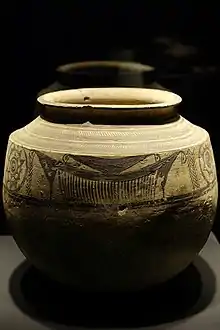 Tepe Giyan IV storage jar - End of 3rd millennium, beginning of 2nd millennium BCE. Tepe Giyan IV. Royal Museums of Art and History - Brussels | |
 Shown within Near East  Tepe Giyan (Iran) | |
| Location | Iran |
|---|---|
| Coordinates | 34°10′53″N 48°14′37″E / 34.18139°N 48.24361°E |
| Type | Settlement |
| Site notes | |
| Condition | In ruins |
Tepe Gyan is an archaeological site in the highland central Zagros Mountains in Iran. Tepe Giyan contains a necropolis of 123 graves and distinctive pottery which displays some affinities with the ceramics found at another Elamite site of Tepe Sialk. Tepe Giyan was first excavated by French archaeologists George Contenau and Roman Ghirshman, with the support of the Musées Nationaux and the École du Louvre, in 1931-32. In 2011, the Tepe Giyan archeological team led by Ali Khaksar discovered a unique Bronze Age burial of a 40-year-old man whose skeleton had bronze rings placed on the maxilla and mandible (upper and lower jaw bones) (Azandaryani, E. H. and A . Khaksar 2013).
Archaeology
Excavations began in 1931. Sealings were discovered.[1][2][3]
History of occupation

The phase of Giyan V (6th-4th millennium BCE) shows ceramic styles with some connections with the region of Susa.[5]
The phase of Giyan IV (End of 3rd millennium, beginning of 2nd millennium BCE) delivers ceramic in abundance. The jars are generally decorated with raised bands in horizontal and wavy raised bands. Only the neck of the jar is painted, the rest is blank. The most significant motifs in this phase are pairs of birds with wings spread in the shape of a comb and rows of sawtooth patterns.
The phase of Tepe Giyan III dates to the period 2000/1900 - 1600 BCE, with specific types of ceramics.[6]
The phase of Tepe Giyan I (1400 — 1100 BCE) shows that iron was still rather scarce in this site and in the areas, a Persia in general at that time, with only a few daggers, spear-heads and arrow-heads, rings and bracelets being found.[7]
Necropolis
The site is mainly known as a necropolis of 121 graves. In 2011, Mr. Khaksar's archeological team discovered a unique burial specimen that had been operated on the cheeks and knees of a bronze ring skeleton of a 40-year-old man. The archaeologist named this grave Grave No. 123. A complete description of the study on an ancient book written by Mr. Ali Akbar Kiani, Ancient Land Gyan. It bears similarities with the site of Tepe Sialk, in the same general area, and its oldest ceramics are also related to the Ubaid period in Mesopotamia.[8]
 Footed Urn, 3rd millennium BCE
Footed Urn, 3rd millennium BCE Potsherd ornated with bustards. Tepe Giyan, 1800-1500 BCE
Potsherd ornated with bustards. Tepe Giyan, 1800-1500 BCE
References
- ↑ Caldwell, David H. “The Early Glyptic of Gawra, Giyan, and Susa, and the Development of Long Distance Trade.” Orientalia, vol. 45, 1976, pp. 227–50
- ↑ Contenau, G., and R. Ghirshman. “Rapport Préliminaire Sur Les Fouilles de Tépé-Giyan, Près Néhavend (Perse) Première Campagne (1931).” Syria, vol. 14, no. 1, 1933, pp. 1–11
- ↑ Conteneau, G., and R. Ghirshman. "Fouilles de Tepe-Giyan près de Néhavend 1931 et 1932. Paris." (1935)
- ↑ "Stamp-seal British Museum". The British Museum.
- ↑ Mutin, Benjamin (2012). "Cultural Dynamics in Southern Middle Asia in the fifth and fourth millennia BC: A reconstruction based on ceramic tradition". Paléorient. 38 (1): 159–184. doi:10.3406/paleo.2012.5467.
- ↑ Bellelli, Gloria M. (2002). Vasi iranici in metallo dell'Età del Bronzo (in Italian). Franz Steiner Verlag. p. 74. ISBN 978-3-515-07818-4.
- ↑ Studies in Ancient Technology. Brill Archive. p. 244.
- ↑ Leroux, Ernest (1953). Revue archéologique (in French). p. 116.